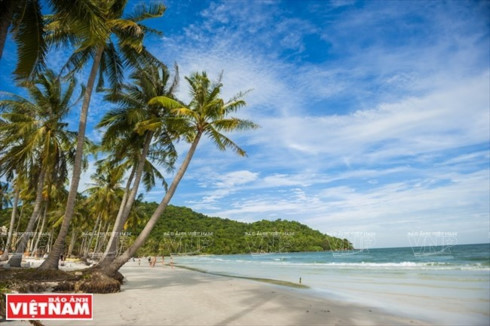
Phu Quoc and Mui Ne beaches of Vietnam have been listed among 20 most idyllic beaches in Asia by CNN travel.

Located in southern
Kien Giang province, Phu Quoc is frequently touted one of Vietnam’s most
beautiful islands and its renowned Bai Dai Beach is blissfully secluded with
white sands and expansive vitas stretching to the horizon, the website said.
Phu Quoc island district is well-connected with international airports, home to
luxurious resorts and foreign visitors can enjoy 30 day visa-free stay on this
island.
Phu Quoc is the largest Vietnamese island with a total area of 574 square
kilometres and a permanent population of approximately
85,000. In 2006, it was
recognised as a World Biosphere Reserve by UNESCO.
In the first five
months of this year, the island welcomed nearly 858,000 arrivals, more than 47
percent of the yearly target, up 21 percent from the same period last year. The
figure includes nearly 181,000 international tourists, or 60 percent of the
yearly target, up 30 percent year on year.
Meanwhile, Mui Ne beach in the central province of Binh Thuan is famous for
adventurous activities, particularly wind-surfing and kite-surfing, due to its
warm temperature and clear skies. It also consists of massive sand dunes,
suitable for activities such as sand-boarding.
Mui Ne boasts many attractive landscapes such as Hon Rom, Hon Lao Cau and Bai
Rang. Coming to this beach, travellers also have the chance to witness the
daily life of fishermen in a humble fishing village.
Other beaches on the list by CNN Travel are Yunokawa (Hakodata, Japan), Patnem
Beach (Goa, India), Tanjung Rhu (Langkawi, Malaysia) and Hikkaduwa (Sri Lanka),
among others.
Source: VOV
A diverse chain of eco-tourism and resort destinations concentrated in Hoa Binh city and the districts of Tan Lac, Da Bac, and Luong Son… Along with the launch of several key high-quality resort tourism projects, these developments have reshaped the landscape and enhanced the appeal of Hoa Binh as a travel destination.
Boasting diverse terrain, a mild climate, and rich natural resources, Cao Phong district is increasingly asserting its place on Vietnam’s tourism map, attracting both domestic and foreign visitors. The district is renowned for its stunning landscapes, majestic mountains, a crystal-clear hydropower lake, and the unique cultural identity of local ethnic groups.
With its pristine landscapes, unique cultural heritage of Muong ethnic minority, and an expanding range of visitor experiences, Tan Lac district of Hoa Binh has fast become a captivating destination for both domestic and international tourists.
Until now, Sung village in Cao Son commune, Da Bac district remains the only Dao ethnic community in Hoa Binh province to develop a community-based tourism model. Beyond its untouched natural landscapes, cultural identity serves as the cornerstone attraction for visitors.
Alongside the diverse cultural identities of the Kinh, Muong, Tay, Thai, Dao, and Mong ethnic people, Hoa Binh province is also renowned as the "capital" of the northwestern Vietnamese cuisine, offering unique and distinctive dishes. At festivals, during Lunar New Year (Tet), or on significant family or community occasions, special dishes are prepared, leaving a lasting impression on visitors.
A Phong Linh (Yellow Tabebuia) flower garden in Thang village, Thach Yen commune, Cao Phong district is currently in full bloom, drawing a large number of visitors.


